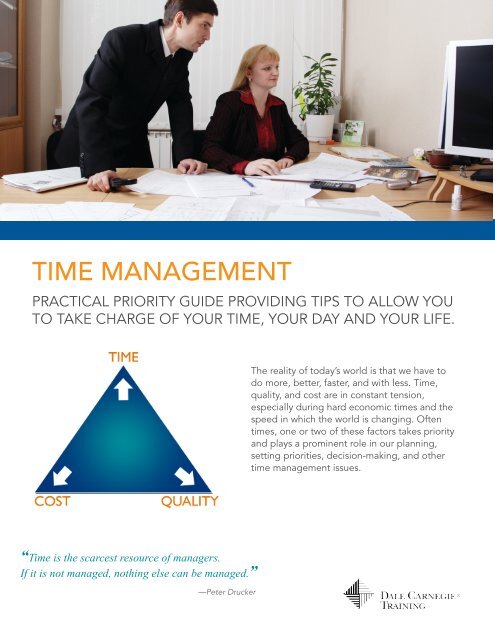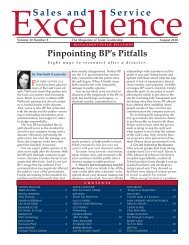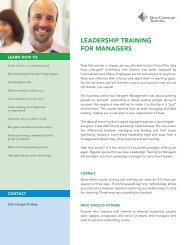TIME MANAGEMENT - sales.dalecarnegie.com
TIME MANAGEMENT - sales.dalecarnegie.com
TIME MANAGEMENT - sales.dalecarnegie.com
Create successful ePaper yourself
Turn your PDF publications into a flip-book with our unique Google optimized e-Paper software.
<strong>TIME</strong> <strong>MANAGEMENT</strong>PRACTICAL PRIORITY GUIDE PROVIDING TIPS TO ALLOW YOUTO TAKE CHARGE OF YOUR <strong>TIME</strong>, YOUR DAY AND YOUR LIFE.The reality of today’s world is that we have todo more, better, faster, and with less. Time,quality, and cost are in constant tension,especially during hard economic times and thespeed in which the world is changing. Oftentimes, one or two of these factors takes priorityand plays a prominent role in our planning,setting priorities, decision-making, and othertime management issues.“Time is the scarcest resource of managers.If it is not managed, nothing else can be managed.”—Peter Drucker
<strong>TIME</strong> <strong>MANAGEMENT</strong>:HOW TO PRIORITIZETime escapes minute by minute and hour by hour. Nothing you do will stop or rewind a clock orcalendar. You all have the same amount of time, 1,440 minutes per day. There are no short-cuts tomanaging yourself more effectively. The key is to invest your time in the most productive way, not onlyfor the sake of your organization but for your own peace of mind. Here are some quick tips to help youprioritize tasks so that you can work more efficiently.1Record All Activities: Write down all your multiple demands, <strong>com</strong>peting priorities, tasks,and activities for the day or week2Determine Primary Goals: List your primary goals for the day or the week3Consider 80/20 Rule: Determine which 20% of activities will yield 80% the results,Bringing you nearer to your goals4Evaluate Important vs. Urgent: Decide which of these activities are the most importantversus the most urgent. At this stage, take into account how certain items affect others andthe consequences for not ac<strong>com</strong>plishing certain tasks (for example, someone might needsomething from you in order to do their job)5Rank: Use a ranking system to begin planning. For example:• “A” tasks have high priority and must be <strong>com</strong>pleted immediately• “B” tasks are moderately important but can be done after the “A” tasks• “C” tasks are of low-level importance and can be tackled in our spare time6Create a Schedule: Indicate deadlines for each task and estimate the time involvedto <strong>com</strong>plete the task. Create a schedule, keeping in mind any tasks that may be linkedtogether to increase productivity. For example, can you couple something of lesser prioritywith something of greater importance?7Revisit Goals and Adjust: Review your goal(s) and the rewards of doing the task on time,and make any necessary adjustments.8Purge: Get rid of items on your list that remain at the bottom and will realistically not getdone.Copyright © 2011 Dale Carnegie & Associates, Inc. All rights reserved.TimeManagement_072111GB
















